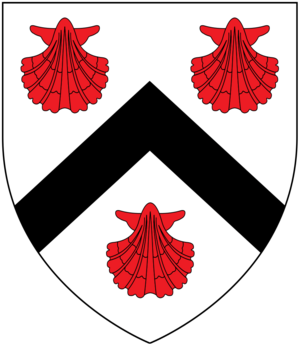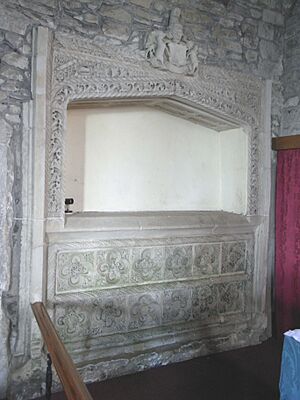Lewis Pollard facts for kids
Sir Lewis Pollard (born around 1465 – died 21 October 1526) was an important judge and politician from Devon, England. He lived at a place called Grilstone, which is in the parish of Bishop's Nympton.
Sir Lewis was a Justice of the Common Pleas, which means he was a judge in one of England's main courts from 1514 to 1526. He also served as a Member of Parliament (MP) for the town of Totnes in 1491. He was a Justice of the Peace (JP) in Devon starting in 1492. He was given the title of knight after 1509.
Sir Lewis Pollard was known as one of many talented people from Devon who became famous lawyers. He was also related to another important judge and Speaker of the House of Commons, Sir John Pollard.
Contents
Who Was Sir Lewis Pollard?
Sir Lewis Pollard came from an old and respected family in Devon. He was the younger son of Robert Pollard. His grandfather was John Pollard of Way, a place near Great Torrington, Devon. His mother was Jane, whose father was William Marwood of Westcott.
A historian named Risdon wrote that Sir Lewis Pollard lived at Grilston before he bought the nearby area of King's Nympton. King's Nympton later became the main home for his family for many years.
His Life as a Lawyer and Judge
Lewis Pollard began his training to become a lawyer at the Middle Temple in London. He became a "Reader" there, which was an important teaching role.
In 1505, he was made one of ten "Sergeants at Law." This was a very special title for top lawyers. There was a huge celebration feast at Lambeth Palace with 1,000 guests, including King Henry VII himself!
In 1507, King Henry VII appointed Pollard as the King's Sergeant-at-Law. This important job was renewed by King Henry VIII three years later. Soon after, King Henry VIII made him a Justice of the Common Pleas, which meant he became a judge. Sir Lewis Pollard served as a judge until he passed away on 21 October 1526.
A writer named Prince described Sir Lewis's career, saying that he handled the important job of a judge with great loyalty and a good reputation. He was known for his knowledge of the law and other good qualities.
Homes and Land
Sir Lewis Pollard bought the area of King's Nympton in Devon. He built a house there and created a deer park. This estate remained the main home for his family for several generations. In the local church, St James, there is a special "Pollard Chapel" with old wooden panels from the 1600s.
He also bought the area of Oakford in August 1507. He paid £203 for it to Sir Charles Brandon, who later became the Duke of Suffolk. The Pollard family owned Oakford until 1604, when it was sold.
Family Life
Sir Lewis Pollard married Agnes Hext. She was the daughter of Thomas Hext, who was also a well-known lawyer from Kingston in Devon.
Sir Lewis and Agnes had a very large family! They had eleven sons and eleven daughters.
Here are some of their notable children:
- Sir Hugh Pollard: He was the oldest son and inherited his father's estates. He served as the Sheriff of Devon and was a "Recorder" (a type of judge) for Barnstaple.
- Sir Richard Pollard (1505–1542): He was the second son and also became a Member of Parliament for Taunton and Devon. He worked for Thomas Cromwell, helping to manage the closing down of religious houses during the Dissolution of the Monasteries.
- John Pollard: He was the third son and became a priest, holding several important church positions like Archdeacon of Wiltshire and Archdeacon of Cornwall.
- Robert Pollard (died 1576): He was the fourth son and bought the area of Knowstone.
- Sir George Pollard: He was the sixth son and was knighted for his bravery in defending Boulogne.
- Jane Pollard: She married Sir Hugh Stucley of Affeton. A special stained-glass window in King's Nympton Church shows the coats of arms of the Stucley and Pollard families, celebrating their marriage.
- Philippa Pollard: She married Sir Hugh Paulet.
- Thomasine Pollard: She married Admiral Sir George Carew.
His Death and Memorial
Sir Lewis Pollard passed away on 21 October 1526, when he was about 61 years old. He was buried in the church at King's Nympton. The historian Risdon wrote that "Judge Pollard lieth honourably interred" in Nymet Church, with a monument built in his memory.
His will, written in 1525, left money for a special chapel to pray for his soul and his family. He also left money to help build a church tower at either Bishop's Nympton or King's Nympton.
In Bishop's Nympton Church, there is a beautifully carved stone monument from the late Gothic period. It is usually thought to be for Sir Lewis Pollard. It is built into the north wall of the church, close to the altar. It might have also been used as an Easter Sepulchre, a special place used during Easter.
A long time ago, in 1630, there was a stained-glass window in Bishop's Nympton Church that showed Sir Lewis Pollard. It probably showed him kneeling, with his ten or eleven sons behind him. On the other side, his wife would have been kneeling too, with her ten or eleven daughters behind her.
There's a famous story about this window: His wife, Agnes, was having the window made while Sir Lewis was away in London. She had already had twenty-one children. She was so sure she would have another child when her husband returned that she asked the glassmaker to add one more child to the window than she actually had at the time. And it came true – she did have another child!
The window also had an inscription that told his name, marriage, job, and how many children he had.
Sources
- Baker, J.H., "Biography of Sir Lewis Pollard", published in History of Parliament: House of Commons 1439–1509, eds. Wedgwood, J.C., & Holt A.D.
- Cherry, Bridget; Pevsner, Nikolaus The Buildings of England: Devon, Penguin Books, 1989. 2nd edition. ISBN: 0-14-071050-7
- Hoskins, W.G., A New Survey of England: Devon, London, 1959
- Prince, John, Worthies of Devon, pp. 640–644
- Risdon, Tristram, Survey of Devon, 1630, 1810 ed.
- Vivian, Lt.Col. J.L., (Ed.) The Visitations of the County of Devon: Comprising the Heralds' Visitations of 1531, 1564 & 1620, Exeter, 1895



